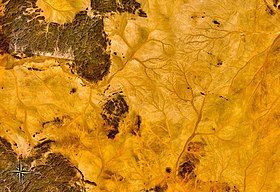


The Bayuda Desert, located at 18°N 33°E / 18°N 33°E, is in the eastern region of the Sahara Desert, spanning approximately 100,000 km2 of northeast Sudan north of Omdurman and south of Korti, embraced by the great bend of the Nile in the north, east, and south and limited by the Wadi Muqaddam in the west. The north-to-south-aligned Wadi Abu Dom divides the Bayuda Desert into the eastern Bayuda Volcanic Field and the western ochre-colored sand-sheets scattered with rocky outcrop.[1]
Gold mining occurs today from October to March, as laborers work auriferous quartz found in wadis and shallow mines. These workings are usually in areas previously worked during the New Kingdom of Egypt and the Early Arab Period.[2] In July 2020, it was found that gold hunters had used heavy machinery at the Jabal Maragha archaeological site, destroying it by digging a huge trench. The gold diggers were arrested and their equipment seized, but they were later released without charges.[3][4]
- ^ Description of the Bayuda Desert
- ^ Klemm, Rosemarie; Klemm, Dietrich (2013). Gold and Gold Mining in Ancient Egypt and Nubia. Heidelberg: Springer. pp. 591–599, 619. ISBN 9783642225079.
- ^ Ketz, Sammy (August 23, 2020). "Gold-hunting diggers destroy Sudan's priceless past". news.yahoo.com. AFP. Retrieved August 24, 2020.
- ^ "Illegal gold diggers destroy ancient Sudanese site". BBC News. 24 August 2020. Retrieved 25 August 2020.